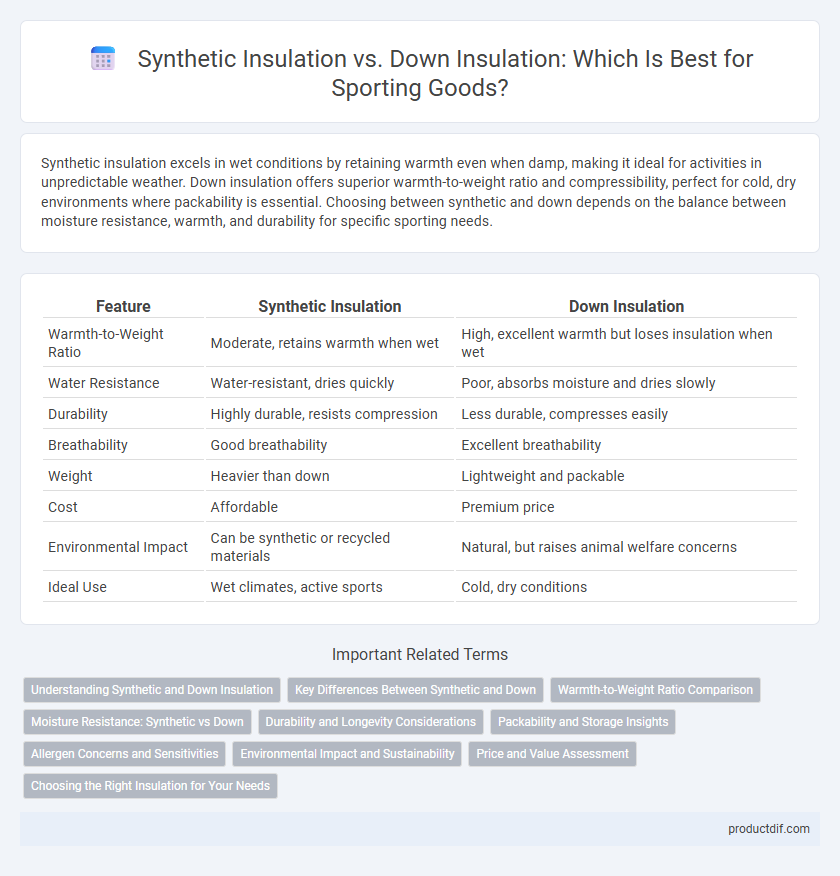Synthetic insulation excels in wet conditions by retaining warmth even when damp, making it ideal for activities in unpredictable weather. Down insulation offers superior warmth-to-weight ratio and compressibility, perfect for cold, dry environments where packability is essential. Choosing between synthetic and down depends on the balance between moisture resistance, warmth, and durability for specific sporting needs.
Table of Comparison
| Feature | Synthetic Insulation | Down Insulation |
|---|---|---|
| Warmth-to-Weight Ratio | Moderate, retains warmth when wet | High, excellent warmth but loses insulation when wet |
| Water Resistance | Water-resistant, dries quickly | Poor, absorbs moisture and dries slowly |
| Durability | Highly durable, resists compression | Less durable, compresses easily |
| Breathability | Good breathability | Excellent breathability |
| Weight | Heavier than down | Lightweight and packable |
| Cost | Affordable | Premium price |
| Environmental Impact | Can be synthetic or recycled materials | Natural, but raises animal welfare concerns |
| Ideal Use | Wet climates, active sports | Cold, dry conditions |
Understanding Synthetic and Down Insulation
Synthetic insulation offers superior moisture resistance and maintains warmth when wet, making it ideal for damp or variable conditions. Down insulation provides exceptional warmth-to-weight ratio and compressibility, enhancing comfort and packability in dry, cold environments. Choosing between synthetic and down depends on activity type, climate, and care preferences for optimal performance in sporting goods.
Key Differences Between Synthetic and Down
Synthetic insulation uses polyester fibers designed to mimic down's loft and warmth, maintaining insulation properties when wet, while down insulation is made from natural goose or duck feathers providing superior warmth-to-weight ratio and compressibility. Synthetic insulation is generally more affordable, dries faster, and performs better in damp conditions, whereas down is more breathable and offers longer durability if properly cared for. Choosing synthetic is ideal for wet climates and budget-conscious consumers, while down suits those seeking lightweight, highly compressible warmth for dry, cold environments.
Warmth-to-Weight Ratio Comparison
Synthetic insulation offers a more consistent warmth-to-weight ratio in wet or damp conditions compared to down insulation, which loses loft and thermal efficiency when exposed to moisture. Down insulation provides superior warmth-to-weight performance in dry environments, delivering higher insulation with less bulk and weight. Choosing between synthetic and down depends on the expected weather conditions and activity level, balancing moisture resistance against compressibility and thermal efficiency.
Moisture Resistance: Synthetic vs Down
Synthetic insulation excels in moisture resistance by retaining warmth even when wet, making it ideal for damp or wet conditions. Down insulation loses much of its insulating ability when wet, as the clusters clump together, reducing loft and heat retention. Therefore, synthetic insulation is preferred for activities in wet environments due to its superior moisture-wicking and quick-drying properties.
Durability and Longevity Considerations
Synthetic insulation offers superior durability and maintains its insulating properties when exposed to moisture, making it ideal for wet and rugged conditions. Down insulation excels in lightweight warmth but loses loft and effectiveness when wet, reducing its longevity in harsh environments. For long-term performance in varying weather, synthetic insulation provides more reliable durability and sustained thermal efficiency.
Packability and Storage Insights
Synthetic insulation offers superior packability and retains its loft and warmth even when compressed or wet, making it ideal for variable weather conditions and frequent storage. Down insulation provides exceptional compressibility and lightweight warmth, but loses insulating power when damp and requires careful storage in a dry environment to maintain loft and longevity. Choosing between these insulations depends on prioritizing moisture resistance and ease of storage versus maximum warmth-to-weight ratio.
Allergen Concerns and Sensitivities
Synthetic insulation offers a hypoallergenic alternative to down, making it ideal for individuals with allergies or sensitivities to feathers. Unlike down insulation, synthetic materials resist mold, mildew, and dust mites, reducing the risk of allergic reactions. This makes synthetic insulated sporting goods preferable for users seeking safe and comfortable options without compromising warmth.
Environmental Impact and Sustainability
Synthetic insulation, made from polyester fibers, has a lower environmental impact in terms of animal welfare and is fully recyclable, but its production relies on fossil fuels, contributing to carbon emissions. Down insulation, sourced from duck or goose feathers, is biodegradable and offers superior warmth-to-weight ratio, reducing material usage and waste. Choosing sustainable options within both types, such as recycled synthetic fibers or certified responsible down, minimizes ecological footprints and supports eco-friendly sporting goods.
Price and Value Assessment
Synthetic insulation typically costs less upfront than down insulation, offering more affordable options for budget-conscious consumers. While down provides superior warmth-to-weight ratio and compressibility, synthetic insulation maintains insulation quality when wet, delivering better value in damp or variable conditions. When assessing price and value, synthetic materials offer reliable performance and durability at a lower cost, whereas down insulation represents a premium investment for optimal thermal efficiency and lightweight comfort.
Choosing the Right Insulation for Your Needs
Synthetic insulation excels in wet conditions due to its moisture-wicking properties, maintaining warmth even when damp. Down insulation offers superior warmth-to-weight ratio and compressibility, making it ideal for dry, cold environments. Consider activity level, weather conditions, and packability to choose between synthetic or down insulation for optimal performance in sporting activities.
Synthetic Insulation vs Down Insulation Infographic

 productdif.com
productdif.com